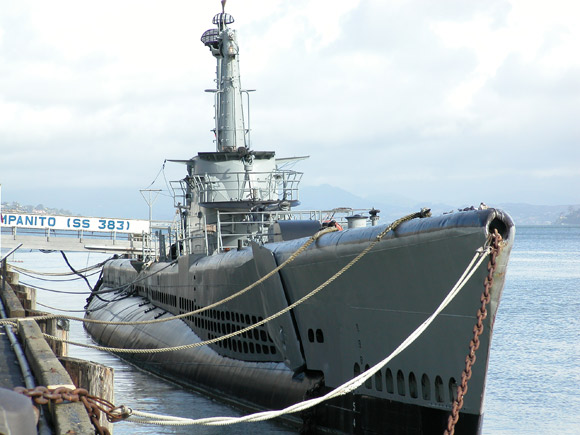TOUR OF USS PAMPANITO (SS-383) Welcome aboard the USS Pampanito online tour. During the late 1930's, the United States was gradually building up its fleet to the limits authorized by the Washington Naval Treaty. The pace quickened when in 1939 World War II began in Europe. However, it was the fall of France in June 1940 that caused the full mobilization of the nation. By the 7 Dec 1941 Imperial Japanese attack on Pearl Harbor, the United States had started an enlarged submarine building program. Pampanito was built in 1943 at the Navy Yard Portsmouth, New Hampshire, in just 9 months, and at a cost of 6 million dollars. She was one of the most advanced fighting systems of her day. By 1943, the role of U.S. submarines was to control the shipping lanes, gather intelligence, and a few special missions. The same roles played by submarines today. Far beyond any expectations at the start of the war, the U.S. Navy fleet submarines were instrumental in the Allied victory in the Pacific. Today, Pampanito serves as a museum and a memorial to the submarine service of the U.S. Navy -- which we proudly call the "Silent Service". World War II submarines typically carried a crew of 70 men and 10 officers. The submarine service was a small, well trained, elite group. They represented less than two percent of all U.S. Navy personnel, and yet they were responsible for fifty-five percent of all Imperial Japanese tonnage sunk, including one third of their warships. This was not without cost, for the submarine force recorded the highest percentage of men lost in the U.S. military, 24%: more than 3500 men in 52 submarines did not return. They are said to be on eternal patrol. To this day all submariners are volunteers. USS Pampanito and her crew were successful during her 6 war patrols in the Pacific. When the war ended she returned to San Francisco. From 1945-1960 she was unused, mothballed, but maintained to be reactivated if needed. From 1961-1970 she was used as a shore side training platform, never to dive again. After that she was again unused until she became a museum and memorial in 1982. With the exception of the hatch and ladders used by visitors to enter and leave her, the submarine is virtually as she was in 1945. We hope this online tour will provide you with a glimpse of what life was like for the sailors aboard this remarkable vessel. It will also enable you visit some compartments that are not safely accessible because of the vertical ladders and confined space. We hope you will be able to visit Pampanito in person some day soon to experience life aboard a real World War II submarine.
Throughout the tour, click on the Your virtual reality tour of the USS Pampanito begins on the Main Deck Aft. To provide the best experience possible without knowing what software is installed on your computer, or how fast your internet connection is, we have several viewing choices. (Fast photos is great for slow internet connections and for visually impaired users with an Internet reader.)
Click on a compartment below to visit the tour in any order: 
Solving problems viewing the panographic images.
|

 MP3 icons to hear sounds and stories. If you are planning a visit to Pampanito you can
MP3 icons to hear sounds and stories. If you are planning a visit to Pampanito you can